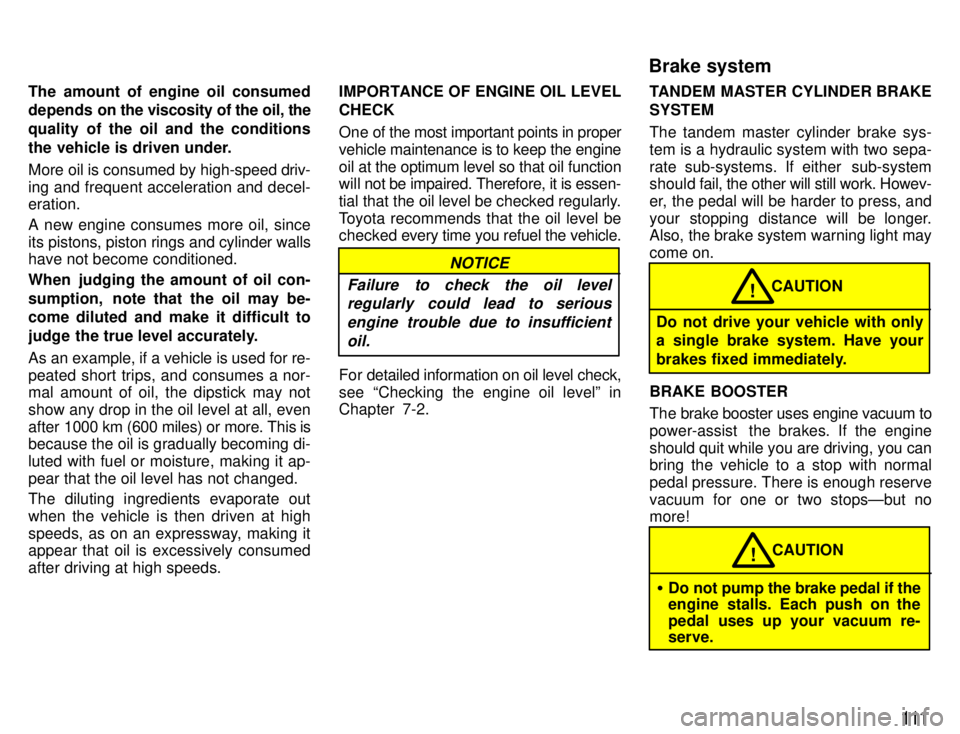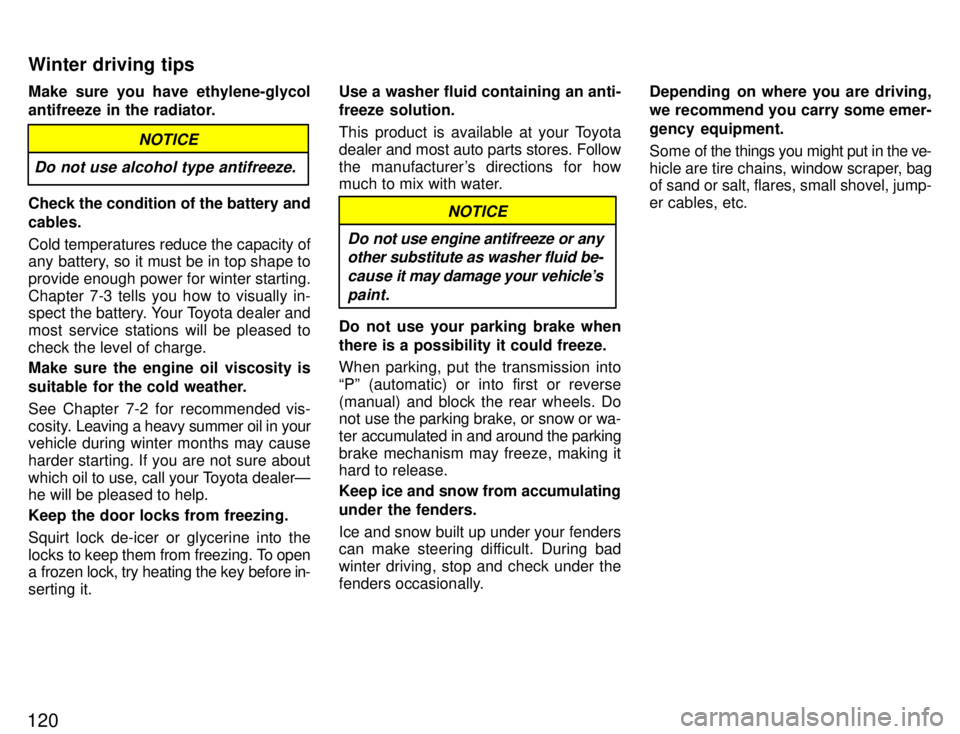1996 TOYOTA SUPRA oil viscosity
[x] Cancel search: oil viscosityPage 113 of 188

111
The amount of engine oil consumed
depends on
the viscosity of the oil, the
quality of the oil and the conditions
the vehicle is driven under.
More oil is consumed by high-speed driv-
ing and frequent acceleration and decel- eration.
A new engine consumes more oil, since
its pistons, piston rings and cylinder walls
have not become conditioned.
When judging the amount of oil con-
sumption, note that the oil may be- come diluted and make it difficult to
judge the true level accurately.
As an example, if a vehicle is used for re-
peated short trips, and consumes a nor- mal amount of oil, the dipstick may not
show any drop in the oil level at all, even
after 1000 km (600 miles) or more. This is
because the oil is gradually becoming di-
luted with fuel or moisture, making it ap-
pear that the oil level has not changed.
The diluting ingredients evaporate out
when the vehicle is then driven at high
speeds, as on an expressway, making it appear that oil is excessively consumed
after driving at high speeds. IMPORTANCE OF ENGINE OIL LEVEL CHECK
One of the most important points in proper vehicle maintenance is to keep the engine
oil at the optimum level so that oil function
will
not be impaired. Therefore, it is essen-
tial that the oil level be checked regularly.
Toyota recommends that the oil level be checked every time you refuel the vehicle.
NOTICE
Failure to check the oil level regularly could lead to serious
engine trouble due to insufficientoil.
For detailed information on oil level check,
see Checking the engine oil levelº in Chapter 7-2. TANDEM MASTER CYLINDER BRAKE SYSTEM
The tandem master cylinder brake sys-
tem is a hydraulic system with two sepa-
rate sub-systems. If either sub-system
should fail, the other w
ill still work. Howev-
er, the pedal will be harder to press, and
your stopping distance will be longer.
Also, the brake system warning light may come on.
Do not drive your vehicle with only
a single brake system. Have your
brakes fixed immediately.
CAUTION!
BRAKE BOOSTER
The brake booster uses engine vacuum to
power-assist the brakes. If the engine
should quit while you are driving, you can
bring the vehicle to a stop with normal
pedal pressure. There is enough reservevacuum for one or two stopsÐbut no more!
� Do not pump the brake pedal if the
engine stalls. Each push on the
pedal uses up your vacuum re- serve.
CAUTION!
Brake system
Page 122 of 188

120Make sure you have ethylene-glycol
antifreeze in the radiator.
Do not use alcohol type antifreeze.
NOTICE
Check the condition of the battery and cables. Cold temperatures reduce the capacity of
any battery, so it must be in top shape to provide enough power for winter starting.Chapter 7-3 tells you how to visually in-
spect the battery. Your Toyota dealer and
most service stations will be pleased tocheck the level of charge.
Make sure the engine oil viscosity is
suitable for the cold weather.
See Chapter 7-2 for recommended vis-
cosity.
Leaving a heavy summer oil in your
vehicle during winter months may cause
harder starting. If you are not sure about
which oil to use, call your Toyota dealerÐ
he will be pleased to help. Keep the door locks from freezing. Squirt lock de-icer or glycerine into the
locks to keep them from freezing. To open
a frozen lock, try heating the key before in-serting it. Use a washer fluid containing an anti-
freeze solution.
This product is available at your Toyota
dealer and most auto parts stores. Follow
the manufacturer's directions for how
much to mix with water.NOTICE
Do not use engine antifreeze or any other substitute as washer fluid be-
cause it may damage your vehicle's
paint.
Do not use your parking brake when there is a possibility it could freeze. When parking, put the transmission into
Pº (automatic) or into first or reverse
(manual) and block the rear wheels. Do
not use the parking brake, or snow or wa-
ter accumulated in and around the parkingbrake mechanism may freeze, making it
hard to release. Keep ice and snow from accumulating
under the fenders.
Ice and snow built up under your fenders
can make steering difficult. During bad winter driving, stop and check under the
fenders occasionally. Depending on where you are driving,
we recommend you carry some emer- gency equipment.
Some of
the things you might put in the ve-
hicle are tire chains, window scraper, bag of sand or salt, flares, small shovel, jump- er cables, etc.
Winter driving tips
Page 154 of 188

152Here is a list of parts and tools you will
need on performing do-it-yourself main-
tenance. Remember all Toyota parts are
designed in metric sizes, so your tools
must be metric. Checking the engine oil level Parts (if level is low): �
Engine oil API SH, Energy-Conserv-
ing IIº multigrade or ILSAC multigrade
having viscosity proper for your cli-mate
Tools: � Rag or paper towel
� Funnel (only for adding oil)
Checking the engine coolant level Parts (if level is low): � Ethylene-glycol antifreeze
� Demineralized or distilled water
Tools: � Funnel (only for adding coolant)
Checking brake fluid Parts (if level is low): � SAE J1703 or FMVSS No. 116 DOT 3 brake fluid
Tools: � Rag or paper towel
� Funnel (only for adding fluid) Checking power steering fluid Parts (if level is low): �
Automatic transmission fluid DEXRON )
-II or -III
Tools: � Rag or paper towel
� Funnel (only for adding fluid)
Checking battery condition Non-maintenance batteriesÐ
Tools: � Warm water
� Baking soda
� Grease
� Conventional wrench (for terminal clamp bolts)
Maintenance type batteriesÐ Parts (if level is low): � Distilled water
Tools:� Warm water
� Baking soda
� Grease
� Conventional wrench (for terminal clamp bolts)
� Coin (for vent plugs)
� Funnel (only for adding distilled water) Checking and replacing fuses Parts (if replacement is necessary): �
Fuse with same amperage rating as original
Adding washer fluid Parts: � Water
� Washer fluid containing antifreeze (for winter use)
Tools: � Funnel
Replacing light bulbs Parts: � Bulb with same number and wattage rating as original (See charts in Re-
placing light bulbsº in Chapter 7-3.)
Tools: � Screwdriver
Parts and tools
Page 183 of 188

181
COOLING SYSTEM
Total capacity, L (qt., Imp. qt.):
2JZ-GE engineWith manual transmission 7.3 (7.7, 6.4)
With automatic transmission 8.3 (8.8, 7.3)
2JZ-GTE engine With manual transmission
9.5 (10.0, 8.4)
With automatic transmission
9.4 (9.9, 8.3)
Coolant type:
With ethylene-glycol antifreeze (Do not use alcohol type.)
BATTERY Open voltage* at 20 �C (68 �F):
12.7 V Fully charged
12.3 V Half charged
11.9 V Discharged
*: Voltage that is checked 20 minutes af-
ter the key is removed with all the lights
turned off Charging rates:
5 A max. CLUTCH
Pedal freeplay, mm (in.):
5' 15 (0.2 '0.6)
Fluid type:
SAE J1703 or FMVSS No. 116 DOT 3
MANUAL TRANSMISSION (2JZ-GE engine only)
Oil capacity, L (qt., Imp. qt.):
2.6 (2.7, 2.3) Oil type:
Multipurpose gear oil API GL-4 or GL-5
Recommended oil viscosity:
SAE 75W-90
AUTOMATIC TRANSMISSION Fluid capacity (drain and refill), L (qt., Imp. qt.):
2JZ-GE engine Up to 1.6 (1.7, 1.4)
2JZ-GTE engine Up to 1.9 (2.0, 1.7)
Fluid type: 2JZ-GE engine
Automatic transmission fluid DII or DEXRON )
-II
2JZ-GTE engine Automatic transmission fluidTYPE T-II or equivalent DIFFERENTIAL
Oil capacity, L (qt., Imp. qt.):
1.35 (1.43, 1.19)
Oil type: Hypoid gear oil API GL-5
Recommended oil viscosity: Above -18 5C (0 5F)
SAE 90
Below -18 5C (0 5F)
SAE 80W or 80W-90
BRAKES Minimum pedal clearance when depressed, mm (in.):
2JZ-GE engine 72 (2.8)
2JZ-GTE engine 70 (2.8)
Pedal freeplay, mm (in.):
1Ð6 (0.04Ð0.24)
Pad wear limit, mm (in.):
1.0 (0.04)
Lining wear limit, mm (in.): 1.0 (0.04)
Parking brake adjustment: 5' 8 clicks
Fluid type: SAE J1703 or FMVSS No. 116 DOT 3